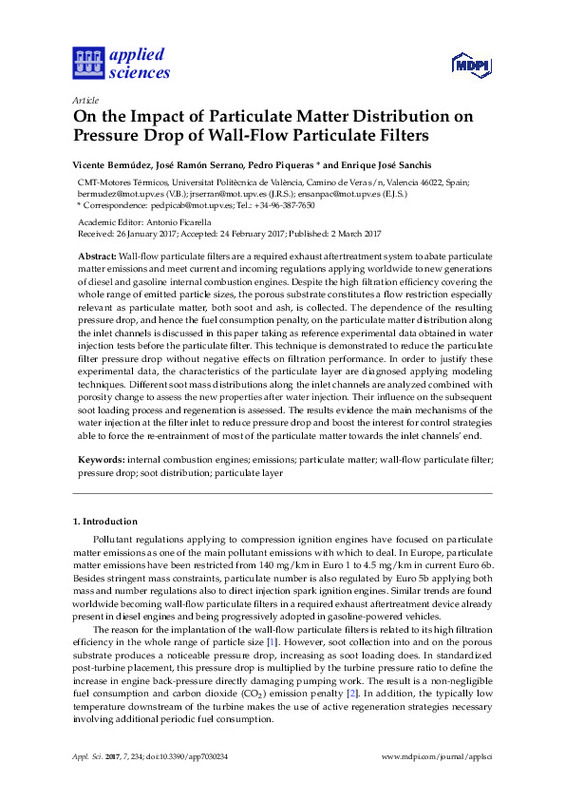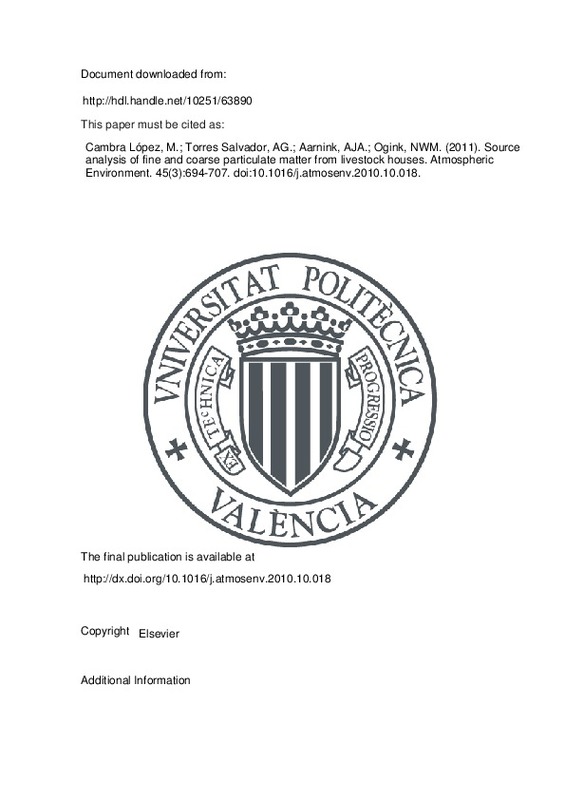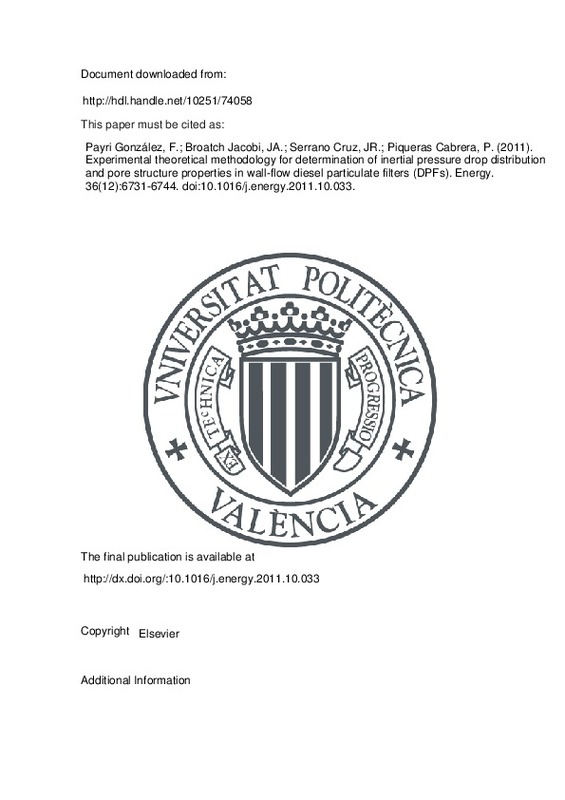JavaScript is disabled for your browser. Some features of this site may not work without it.
Buscar en RiuNet
Listar
Mi cuenta
Estadísticas
Ayuda RiuNet
Admin. UPV
On the Impact of Particulate Matter Distribution on Pressure Drop of Wall-Flow Particulate Filters
Mostrar el registro sencillo del ítem
Ficheros en el ítem
| dc.contributor.author | Bermúdez, Vicente
|
es_ES |
| dc.contributor.author | Serrano, J.R.
|
es_ES |
| dc.contributor.author | Piqueras, P.
|
es_ES |
| dc.contributor.author | Sanchis-Pacheco, Enrique José
|
es_ES |
| dc.date.accessioned | 2020-07-30T03:34:36Z | |
| dc.date.available | 2020-07-30T03:34:36Z | |
| dc.date.issued | 2017-03-02 | es_ES |
| dc.identifier.uri | http://hdl.handle.net/10251/148876 | |
| dc.description.abstract | [EN] Wall-flow particulate filters are a required exhaust aftertreatment system to abate particulate matter emissions and meet current and incoming regulations applying worldwide to new generations of diesel and gasoline internal combustion engines. Despite the high filtration efficiency covering the whole range of emitted particle sizes, the porous substrate constitutes a flow restriction especially relevant as particulate matter, both soot and ash, is collected. The dependence of the resulting pressure drop, and hence the fuel consumption penalty, on the particulate matter distribution along the inlet channels is discussed in this paper taking as reference experimental data obtained in water injection tests before the particulate filter. This technique is demonstrated to reduce the particulate filter pressure drop without negative effects on filtration performance. In order to justify these experimental data, the characteristics of the particulate layer are diagnosed applying modeling techniques. Different soot mass distributions along the inlet channels are analyzed combined with porosity change to assess the new properties after water injection. Their influence on the subsequent soot loading process and regeneration is assessed. The results evidence the main mechanisms of the water injection at the filter inlet to reduce pressure drop and boost the interest for control strategies able to force the re-entrainment of most of the particulate matter towards the inlet channels' end. | es_ES |
| dc.description.sponsorship | This work has been partially supported by the Spanish Ministry of Economy and Competitiveness through Grant No. TRA2016-79185-R. Additionally, the Ph.D. student Enrique Jose Sanchis has been funded by a grant from Universitat Politecnica de Valencia with the reference FPI-2016-S2-1355. | es_ES |
| dc.language | Inglés | es_ES |
| dc.publisher | MDPI AG | es_ES |
| dc.relation.ispartof | Applied Sciences | es_ES |
| dc.rights | Reconocimiento (by) | es_ES |
| dc.subject | Internal combustion engines | es_ES |
| dc.subject | Emissions | es_ES |
| dc.subject | Particulate matter | es_ES |
| dc.subject | Wall-flow particulate filter | es_ES |
| dc.subject | Pressure drop | es_ES |
| dc.subject | Soot distribution | es_ES |
| dc.subject | Particulate layer | es_ES |
| dc.subject.classification | MAQUINAS Y MOTORES TERMICOS | es_ES |
| dc.title | On the Impact of Particulate Matter Distribution on Pressure Drop of Wall-Flow Particulate Filters | es_ES |
| dc.type | Artículo | es_ES |
| dc.identifier.doi | 10.3390/app7030234 | es_ES |
| dc.relation.projectID | info:eu-repo/grantAgreement/UPV//FPI-2016-S2-1355/ | es_ES |
| dc.relation.projectID | info:eu-repo/grantAgreement/MINECO//TRA2016-79185-R/ES/DESARROLLO DE HERRAMIENTAS EXPERIMENTALES Y COMPUTACIONALES PARA LA CARACTERIZACION DE SISTEMAS DE POST-TRATAMIENTO DE GASES DE ESCAPE EN MOTORES DE ENCENDIDO POR COMPRESION/ | es_ES |
| dc.rights.accessRights | Abierto | es_ES |
| dc.contributor.affiliation | Universitat Politècnica de València. Departamento de Máquinas y Motores Térmicos - Departament de Màquines i Motors Tèrmics | es_ES |
| dc.description.bibliographicCitation | Bermúdez, V.; Serrano, J.; Piqueras, P.; Sanchis-Pacheco, EJ. (2017). On the Impact of Particulate Matter Distribution on Pressure Drop of Wall-Flow Particulate Filters. Applied Sciences. 7(3):1-21. https://doi.org/10.3390/app7030234 | es_ES |
| dc.description.accrualMethod | S | es_ES |
| dc.relation.publisherversion | https://doi.org/10.3390/app7030234 | es_ES |
| dc.description.upvformatpinicio | 1 | es_ES |
| dc.description.upvformatpfin | 21 | es_ES |
| dc.type.version | info:eu-repo/semantics/publishedVersion | es_ES |
| dc.description.volume | 7 | es_ES |
| dc.description.issue | 3 | es_ES |
| dc.identifier.eissn | 2076-3417 | es_ES |
| dc.relation.pasarela | S\329091 | es_ES |
| dc.contributor.funder | Universitat Politècnica de València | es_ES |
| dc.contributor.funder | Ministerio de Economía y Competitividad | es_ES |
| dc.description.references | Johnson, T. V. (2015). Review of Vehicular Emissions Trends. SAE International Journal of Engines, 8(3), 1152-1167. doi:10.4271/2015-01-0993 | es_ES |
| dc.description.references | Bermúdez, V., Serrano, J. R., Piqueras, P., & García-Afonso, O. (2011). Assessment by means of gas dynamic modelling of a pre-turbo diesel particulate filter configuration in a turbocharged HSDI diesel engine under full-load transient operation. Proceedings of the Institution of Mechanical Engineers, Part D: Journal of Automobile Engineering, 225(9), 1134-1155. doi:10.1177/0954407011402278 | es_ES |
| dc.description.references | Subramaniam, M. N., Joergl, V., Keller, P., Weber, O., Toyoshima, T., & Vogt, C. D. (2009). Feasibility Assessment of a Pre-turbo After-Treatment System with a 1D Modeling Approach. SAE Technical Paper Series. doi:10.4271/2009-01-1276 | es_ES |
| dc.description.references | Luján, J. M., Bermúdez, V., Piqueras, P., & García-Afonso, Ó. (2015). Experimental assessment of pre-turbo aftertreatment configurations in a single stage turbocharged diesel engine. Part 1: Steady-state operation. Energy, 80, 599-613. doi:10.1016/j.energy.2014.05.048 | es_ES |
| dc.description.references | Luján, J. M., Serrano, J. R., Piqueras, P., & García-Afonso, Ó. (2015). Experimental assessment of a pre-turbo aftertreatment configuration in a single stage turbocharged diesel engine. Part 2: Transient operation. Energy, 80, 614-627. doi:10.1016/j.energy.2014.12.017 | es_ES |
| dc.description.references | Lee, J. H., Paratore, M. J., & Brown, D. B. (2008). Evaluation of Cu-Based SCR/DPF Technology for Diesel Exhaust Emission Control. SAE International Journal of Fuels and Lubricants, 1(1), 96-101. doi:10.4271/2008-01-0072 | es_ES |
| dc.description.references | Watling, T. C., Ravenscroft, M. R., & Avery, G. (2012). Development, validation and application of a model for an SCR catalyst coated diesel particulate filter. Catalysis Today, 188(1), 32-41. doi:10.1016/j.cattod.2012.02.007 | es_ES |
| dc.description.references | Marchitti, F., Nova, I., & Tronconi, E. (2016). Experimental study of the interaction between soot combustion and NH3-SCR reactivity over a Cu–Zeolite SDPF catalyst. Catalysis Today, 267, 110-118. doi:10.1016/j.cattod.2016.01.027 | es_ES |
| dc.description.references | Konstandopoulos, A. G., & Kostoglou, M. (2014). Analysis of Asymmetric and Variable Cell Geometry Wall-Flow Particulate Filters. SAE International Journal of Fuels and Lubricants, 7(2), 489-495. doi:10.4271/2014-01-1510 | es_ES |
| dc.description.references | Bollerhoff, T., Markomanolakis, I., & Koltsakis, G. (2012). Filtration and regeneration modeling for particulate filters with inhomogeneous wall structure. Catalysis Today, 188(1), 24-31. doi:10.1016/j.cattod.2011.12.017 | es_ES |
| dc.description.references | Iwata, H., Konstandopoulos, A., Nakamura, K., Ogiso, A., Ogyu, K., Shibata, T., & Ohno, K. (2015). Further Experimental Study of Asymmetric Plugging Layout on DPFs: Effect of Wall Thickness on Pressure Drop and Soot Oxidation. SAE Technical Paper Series. doi:10.4271/2015-01-1016 | es_ES |
| dc.description.references | Bermúdez, V., Serrano, J. R., Piqueras, P., & García-Afonso, O. (2015). Pre-DPF water injection technique for pressure drop control in loaded wall-flow diesel particulate filters. Applied Energy, 140, 234-245. doi:10.1016/j.apenergy.2014.12.003 | es_ES |
| dc.description.references | Serrano, J. R., Bermudez, V., Piqueras, P., & Angiolini, E. (2015). Application of Pre-DPF Water Injection Technique for Pressure Drop Limitation. SAE Technical Paper Series. doi:10.4271/2015-01-0985 | es_ES |
| dc.description.references | Wang, Y., Wong, V., Sappok, A., & Munnis, S. (2013). The Sensitivity of DPF Performance to the Spatial Distribution of Ash Inside DPF Inlet Channels. SAE Technical Paper Series. doi:10.4271/2013-01-1584 | es_ES |
| dc.description.references | Sappok, A., Govani, I., Kamp, C., Wang, Y., & Wong, V. (2013). In-Situ Optical Analysis of Ash Formation and Transport in Diesel Particulate Filters During Active and Passive DPF Regeneration Processes. SAE International Journal of Fuels and Lubricants, 6(2), 336-349. doi:10.4271/2013-01-0519 | es_ES |
| dc.description.references | Torregrosa, A. J., Serrano, J. R., Arnau, F. J., & Piqueras, P. (2011). A fluid dynamic model for unsteady compressible flow in wall-flow diesel particulate filters. Energy, 36(1), 671-684. doi:10.1016/j.energy.2010.09.047 | es_ES |
| dc.description.references | CMT-Motores Tèrmicos (Universitat Politècnica de València)www.openwam.org | es_ES |
| dc.description.references | Lax, P. D., & Wendroff, B. (1964). Difference schemes for hyperbolic equations with high order of accuracy. Communications on Pure and Applied Mathematics, 17(3), 381-398. doi:10.1002/cpa.3160170311 | es_ES |
| dc.description.references | Serrano, J. R., Arnau, F. J., Piqueras, P., & García-Afonso, O. (2013). Application of the two-step Lax and Wendroff FCT and the CE-SE method to flow transport in wall-flow monoliths. International Journal of Computer Mathematics, 91(1), 71-84. doi:10.1080/00207160.2013.783206 | es_ES |
| dc.description.references | Desantes, J. M., Serrano, J. R., Arnau, F. J., & Piqueras, P. (2012). Derivation of the method of characteristics for the fluid dynamic solution of flow advection along porous wall channels. Applied Mathematical Modelling, 36(7), 3134-3152. doi:10.1016/j.apm.2011.09.090 | es_ES |
| dc.description.references | Serrano, J. R., Arnau, F. J., Piqueras, P., & García-Afonso, Ó. (2013). Packed bed of spherical particles approach for pressure drop prediction in wall-flow DPFs (diesel particulate filters) under soot loading conditions. Energy, 58, 644-654. doi:10.1016/j.energy.2013.05.051 | es_ES |
| dc.description.references | Murtagh, M. J., Sherwood, D. L., & Socha, L. S. (1994). Development of a Diesel Particulate Filter Composition and Its Effect on Thermal Durability and Filtration Performance. SAE Technical Paper Series. doi:10.4271/940235 | es_ES |
| dc.description.references | Fino, D., Russo, N., Millo, F., Vezza, D. S., Ferrero, F., & Chianale, A. (2009). New Tool for Experimental Analysis of Diesel Particulate Filter Loading. Topics in Catalysis, 52(13-20), 2083-2087. doi:10.1007/s11244-009-9393-z | es_ES |
| dc.description.references | Konstandopoulos, A. G., & Johnson, J. H. (1989). Wall-Flow Diesel Particulate Filters—Their Pressure Drop and Collection Efficiency. SAE Technical Paper Series. doi:10.4271/890405 | es_ES |
| dc.description.references | Lapuerta, M., Ballesteros, R., & Martos, F. J. (2006). A method to determine the fractal dimension of diesel soot agglomerates. Journal of Colloid and Interface Science, 303(1), 149-158. doi:10.1016/j.jcis.2006.07.066 | es_ES |
| dc.description.references | Serrano, J. R., Climent, H., Piqueras, P., & Angiolini, E. (2016). Filtration modelling in wall-flow particulate filters of low soot penetration thickness. Energy, 112, 883-898. doi:10.1016/j.energy.2016.06.121 | es_ES |
| dc.description.references | Logan, B. E., Jewett, D. G., Arnold, R. G., Bouwer, E. J., & O’Melia, C. R. (1995). Clarification of Clean-Bed Filtration Models. Journal of Environmental Engineering, 121(12), 869-873. doi:10.1061/(asce)0733-9372(1995)121:12(869) | es_ES |
| dc.description.references | Koltsakis, G. C., & Stamatelos, A. M. (1997). Modes of Catalytic Regeneration in Diesel Particulate Filters. Industrial & Engineering Chemistry Research, 36(10), 4155-4165. doi:10.1021/ie970095m | es_ES |
| dc.description.references | Bissett, E. J. (1984). Mathematical model of the thermal regeneration of a wall-flow monolith diesel particulate filter. Chemical Engineering Science, 39(7-8), 1233-1244. doi:10.1016/0009-2509(84)85084-8 | es_ES |
| dc.description.references | Galindo, J., Serrano, J. R., Piqueras, P., & García-Afonso, Ó. (2012). Heat transfer modelling in honeycomb wall-flow diesel particulate filters. Energy, 43(1), 201-213. doi:10.1016/j.energy.2012.04.044 | es_ES |
| dc.description.references | Payri, F., Broatch, A., Serrano, J. R., & Piqueras, P. (2011). Experimental–theoretical methodology for determination of inertial pressure drop distribution and pore structure properties in wall-flow diesel particulate filters (DPFs). Energy, 36(12), 6731-6744. doi:10.1016/j.energy.2011.10.033 | es_ES |
| dc.description.references | Konstandopoulos, A. G., Skaperdas, E., & Masoudi, M. (2002). Microstructural Properties of Soot Deposits in Diesel Particulate Traps. SAE Technical Paper Series. doi:10.4271/2002-01-1015 | es_ES |
| dc.description.references | Bermúdez, V., Serrano, J. R., Piqueras, P., & Campos, D. (2015). Analysis of the influence of pre-DPF water injection technique on pollutants emission. Energy, 89, 778-792. doi:10.1016/j.energy.2015.05.142 | es_ES |











